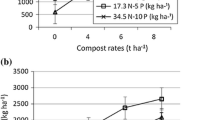Abstract
Chemical maturity parameters in addition to plant growth limiting factors have been monitored in the course of a 2-month composting experiment. Wheat straw with 5% dry w horse manure was adjusted to C/N= 45 with urea. The pile was rotated and homogeneous samples were taken every four days. The most intense changes in straw fractions occurred in the first 20 days of composting, as suggested by wet chemical analyses, thermogravimetry and 13C NMR spectrometry. Nevertheless, plant response to compost application gave significant changes at between 20–60 days that were not clearly reflected by the above techniques. Glasshouse experiments with a soil treated with compost samples taken at the successive transformation stages suggested no linear correlation between composting time and the potential of compost in improving plant yield. In the samples taken after 20 days in the conditions studied, referred to as postmature composts, the ryegrass yield did not depend on most of the organic matter characteristics, but closely paralleled the concentration of available nitrogen and – to lesser extent – phosphorous in the compost. The probable immobilization of these elements in the course of composting was also suggested by plant response experiments with different doses of compost and the addition or not of mineral solution.
Similar content being viewed by others
References
Association of Official Analytical Chemists 1984 AOAC Official Methods of Analysis. 14th ed. Method 14.067. Kjeldahl method. Protein in Grain. 259. Arlington, Virginia, USA.
Almendros G 1989 An analysis of some wheat straw humification factors and their bearing on the response to compost of soil and plant. Sci. Total Environ. 81/82, 569–578.
Almendros G, Polo A and Vizcayno M C 1982 Application of thermal analysis to the study of several Spanish peats. J. Thermal Anal. 24, 175–182.
Almendros G, Fründ R, González-Vila F J, Haider K M, Knicker H and Lüdemann H D 1991 Analysis of 13C and 15N CPMAS NMR-spectra of soil organic matter and composts. FEBS Lett. 282, 119–121.
Bannick C G and Joergensen R G 1993 Change in N fractions during composting of wheat straw. Biol. Fertil. Soils 16, 269–274.
Blanco M J and Almendros G 1994 Maturity assessment of wheat straw composts by thermogravimetric analysis. J. Agr. Food. Chem. 42, 2454–2459.
Box E P, Hunter W G and Hunter J S 1978 Statistics for Experimenters. Chapter 9: An Introduction to Design, Analysis and Model Building. John Wiley & Sons, NY. pp 291–391.
Bray R H and Kurtz L T 1945 Determination of total organic and available forms of phosphorous in soils. Soil Sci. 59, 39–45.
Chen Y, Senesi N and Schnitzer M 1977 Information provided on humic substances by E4/E6 ratios. Soil Sci. Soc. Am. J. 41,352–358.
Fründ R and Lüdemann H D 1989a The quantitative analysis of solution-and CPMAS-C-13 NMR spectra of humic material. Sci. Total Environ. 81/82, 157–168.
Fründ R and Lüdemann H D 1989b 13C-NMR spectroscopy of lignins and lignocellulosic materials. In Physico-chemical Characterisation of Plant Residues for Industrial and Feed Use. Eds. A Chesson and E R Ørskov. pp 110–117. Elsevier, London.
Hirai MF, Chanyasak Vand Kubota H1983Astandardmeasurement for compost maturity. BioCycle (Nov-Dec.), 54–56. Hoagland D R 1944 Inorganic Plant Nutrition. Waltham, Massachusetts,USA.
Hoffman I and Schnitzer M 1965 Thermogravimetric studies on soil humic compounds. In Thermal Analysis '65. Proc. First International Thermal Analysis Conference, Aberdeen, 1965. Ed. J P Redfern. pp 62–63. MacMillan and Co.
Janshekar H, Haltmeier T and Brown C 1982 Fungal degradation of pine and straw alkali lignins. Eur. J. Appl. Microbiol. Biotechnol. 14, 174–181.
Jenkinson D S and Tinsley J 1959 Studies on the organic material extracted fromsoils and compost. I. The isolation and characterization of ligno-proteins from compost. J. Soil Sci. 10, 245–263.
Jhorar B S, Phogat V and Malik R S 1991 Kinetics of composting rice straw with glue waste at different carbon: nitrogen ratios in a semiarid environment. Arid Soil Res. Rehabil. 5, 297–306.
Jorba J and Trillas M I 1983 Rapid bioassay to control maturity in pine bark compost. Acta Hortic. 150, 67–73.
Lynch JM 1976 Products of soil microorganisms in relation to plant growth. Crit. Rev. Microbiol. (Nov.) 67–107.
Mathur S P, Owen G, Dinel H and Schnitzer M 1993 Determination of compost biomaturity. I. Literature review. Biol. Agric. Hortic. 10, 65–85
Martínez-´I ñigo M J and Almendros G 1994 Kinetic study of the composting of evergreen oak forestry waste.Waste Manag. Res.12, 305–314.
Mustin M 1987 Le compost. Gestion de la mati`ere organique. Dubusc, Paris.
Parr J F, Stewart BA, Hornick S B and Singh R P 1990 Improving the sustainability of dryland farming systems, a global perspective. In Adv. Soil Sci. 13, 1–272. Springer-Verlag, New York.
Rule J S, Turley DB and Vaidyanathan LV1991 Straw incorporation into soil compared with burning during successive seasons – impact on crop husbandry and soil nitrogen supply. In Advances in Soil OrganicMatter Research: The Impact onAgriculture and the Environment. Ed. W S Wilson. pp 339–354.
Schnitzer M and Khan S U 1972 Humic Substances in the Environment. Marcel Dekker, New York.
Senesi N 1989 Composted materials as organic fertilizers. Sci. Total Environ. 81/82, 521–542.
TAPPI 1975 Water solubles in wood and pulp. T 207 os-75.
TAPPI 1974 Acid-insoluble lignin in wood and pulp. T 222 os-74.
TAPPI 1976 One per cent sodium hydroxide solubility of wood and pulp. T 212 os-76.
Traina S J, Novak J and Smeck N E 1990 An ultraviolet absorbance method of estimating the percent aromatic carbon content of humic acids. J. Environ. Qual. 19, 151–53.
van Krevelen D W 1950 Graphical-statistical method for the study of structure and reaction processes of coal. Fuel 29, 269–284.
Waksman S E 1936. “Humus”. Williams and Wilkins, Baltimore.
Author information
Authors and Affiliations
Rights and permissions
About this article
Cite this article
Blanco, MJ., Almendros, G. Chemical transformation, phytotoxicity and nutrient availability in progressive composting stages of wheat straw. Plant and Soil 196, 15–25 (1997). https://doi.org/10.1023/A:1004240927483
Issue Date:
DOI: https://doi.org/10.1023/A:1004240927483




